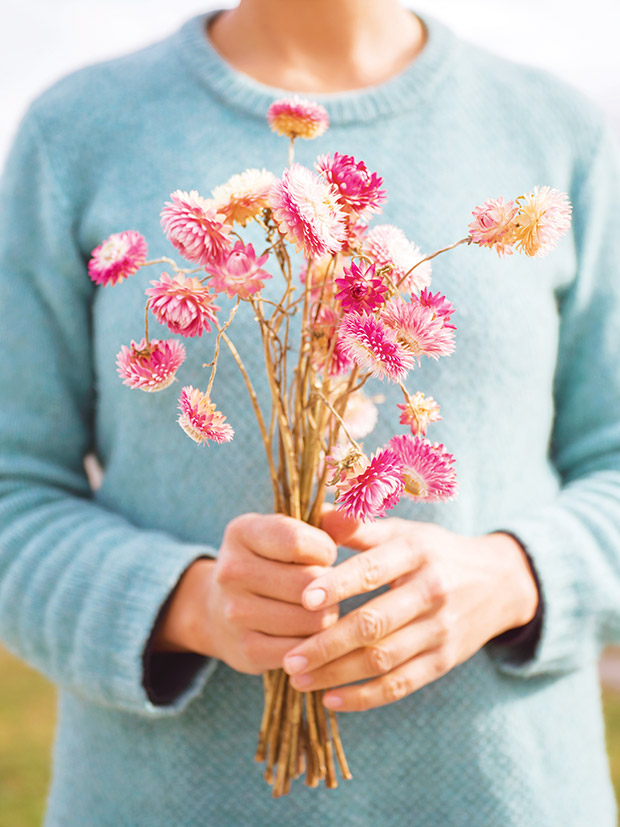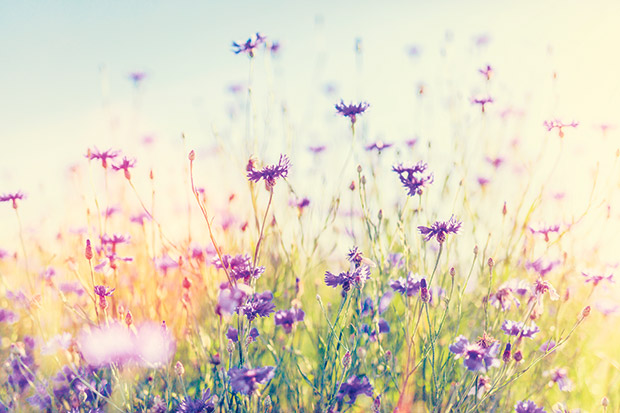Nadia Lim’s tips for drying flowers (plus 10 easy flowers to dry)

Photo: Rachael McKenna.
Modern dried florals embrace the beauty of twisting leaves and wilting petals.
Words: Extract from Nadia: A Seasonal Journal
I love drying bunches of flowers to keep in vases throughout the year. It’s easy to do and they last forever. Air-drying is the simplest method for drying flowers. Once dried, they last for several months or even years. But when you harvest and how you dry them determines their shelf life.
Pick flowers when they are at their peak. If you cut a bloom that is half dead, it will look half dead when dried. Pick on a sunny morning after the dew has evaporated, as moisture on the plants can encourage mould development.
Strip the stems of their leaves and tie them in small bundles to allow the flowers to dry quickly. Bulky bunches may develop mould in the centre, so tie only two or three flower heads together.
Hang upside down by their stems in a warm room with good air circulation. Keep out of direct sunlight otherwise the sun will bleach the flowers. A dry, darkened room is ideal.
Temperature, humidity, and the moisture content of the flowers will determine the drying time, but it usually takes two to three weeks. Your flowers will be fragile when dried, so be careful when arranging.
10 EASY FLOWERS TO DRY

Cornflowers are ideal for drying as they maintain their colour.
1. Hydrangeas: One of the most-loved flowers, hydrangeas have a long flowering season over summer and autumn. They are best picked for drying towards the end of the season – late summer or early autumn – when the flowers still have colour but before they start to fade.
2. Strawflowers: Strawflowers (pictured left) have a straw-like quality and feel dry to the touch even when freshly picked. They retain their colour exceptionally well, so choose a variety of colours for growing and picking. Pick the flowers when the outer layer of petals has opened but when the inner petals remain tight.
3. Statice: Along with strawflowers, statice is one of the easiest flowers to dry. It maintains its colour, and its straw-like flowers maintain their structure.
4. Yarrow: Also known as achillea, yarrow has a collection of tiny blooms that form an umbrella-shaped flower head. Pick the heads when the blooms have just opened.
5. English lavender: The beautiful scent of English lavender remains once dried, as does the colour. Harvest when the flowers are fully open.
6. Roses: Roses are the quintessential flower to dry, but make sure you pick when the flowers are still reasonably tight rather than fully open, or the petals will drop.
7. Globe artichoke: Let artichokes go to flower, and get magnificent, large, purple blooms, which look fabulous in the vase, and can even be dried to prolong their display. Pick the flowers for drying when the white, fluffy seeds are seen in the flower’s centre.
8. Globe amaranth: Also called gomphrena, these ball-shaped flowers come in many colours and are a great candidate for drying. Pick when the flowers are fully open and remove the top two leaves just beneath the flower head.
9. Globe thistle: The ball-shaped flowerheads of the globe thistle slightly fade when dried, but they still maintain their perfect shape. Pick when the globes (the bristle-like bracts) are a bluey-grey purple but before the tiny flowers appear.
10. Larkspur: These summer-flowering blooms provide height for the vase. Pick before all the flowers open – a good time is when half the flowers on the stem are open. They contain a lot of moisture, so you may need a dehumidifier if there is any moisture in the air.
 This article first appeared in Nadia: A Seasonal Journal Magazine.
This article first appeared in Nadia: A Seasonal Journal Magazine.

